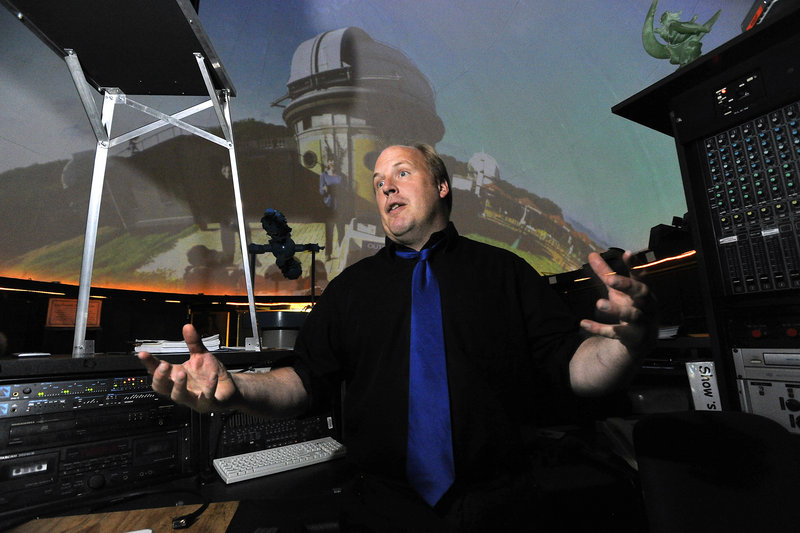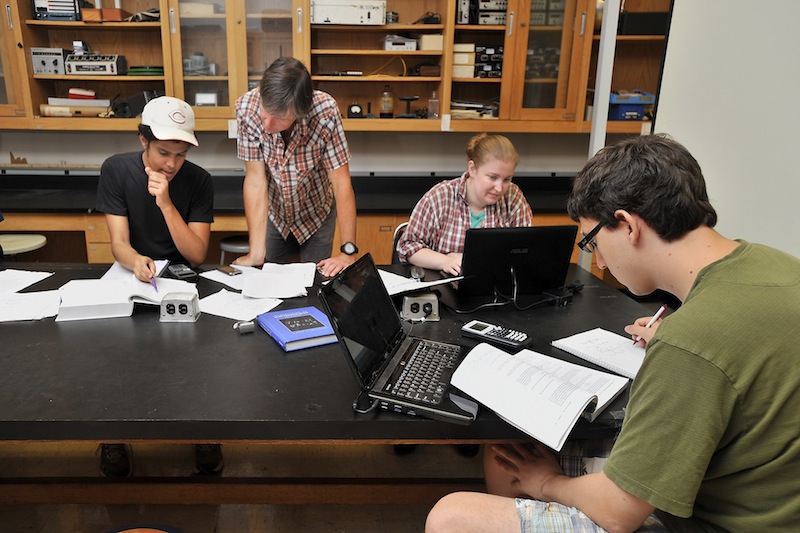PORTLAND – The University of Southern Maine plans to stop offering degrees in physics because of low enrollment, and the school’s president said Thursday that other programs could follow.
The decision to cut the physics major shocked students and prompted professors to vow a fight.
“You can’t call yourself a university if you eliminate something as basic as physics,” said associate physics professor Paul Nakroshis. “It’s not over.”
On Wednesday, Provost and Vice Chancellor of Academic Affairs Michael Stevenson told Nakroshis and department Chairman Jerry LaSala to suspend enrollment of new physics majors immediately and form a plan to dissolve the major, incorporating the staff and classes into other departments.
Eighteen students are now in the program, which generally graduates three or four a year. They will be allowed to finish.
The department has four professors, one of whom plans to retire in 2014.
Introductory physics courses, which students need for many other science degree programs, will continue. But USM will stop offering upper-level courses, about four a year, that are required for the physics degree but regularly have only five or six students.
Stevenson also said in a memo to department heads that the popular Southworth Planetarium, part of the physics department, could be closed. The planetarium, which is the only one in southern Maine, attracts more than 17,000 people a year for a variety of programs.
University officials said Thursday that they intend to keep it open, but Stevenson told the physics department “to develop a plan for its use … or recommend its closure.”
Stevenson was not available for comment Thursday.
OTHER PROGRAMS MAY BE CUT
Ending the physics major is simply a financial decision, said USM President Theodora Kalikow, because the upper-level courses consistently have fewer than 12 students, a baseline for enrollment.
“The financial situation and the academic situation at this campus needs to be addressed,” Kalikow said.
“(Physics) is not the only program we are looking at,” she said. “It’s their turn. There are other programs in different areas, and it will be their turn, too.”
Kalikow would not say what other programs, or how many other programs, are being considered for elimination.
“We have to stop doing many things that are unproductive,” she said.
STUDENTS SHOCKED, INCREDULOUS
Many students heard about the university’s plan Thursday morning.
“Walking around out there, you can tell which ones have heard the news. They all look like they’re in mourning,” said assistant physics professor Julie Ziffer, motioning toward the hallways outside the physics department offices. “They look shocked.”
A handful of physics students who were doing homework between classes said they couldn’t believe the school would make such a move.
“This is so bad,” said junior Ramses Tamayo, looking up from pages of handwritten formulas scattered on a lab table in front of him. Across the table, senior Trevor Hamer agreed.
“Isaac Newton would be rolling in his grave,” Hamer said. “I think it’s ridiculous.”
Nakroshis said he plans to get the Faculty Senate involved and make a case to keep the major, which was created in 1987.
“Don’t worry,” Nakroshis told the students. “I’m not going to let it go down without a fight.”
Nakroshis, who has taught at USM for 16 years, said he has never before had upper-level physics courses cut because of low enrollment.
Besides hurting USM’s ability to attract top instructors and students, cutting the major doesn’t make sense because the department, on average, has large classes and makes money, he said. Introductory physics courses regularly have more than 100 students.
“There’s no financial argument,” said Nakroshis, who did a comprehensive review of the department in 2012, when he served as its chair.
Kalikow said the financial concern is professors teaching small numbers of students, not the average class size or department budget.
UNDER-ENROLLED CLASSES A TARGET
Ziffer said USM’s decision contradicts an effort touted by state and education officials to get more students involved in science, technology, engineering and math. She said physics graduates go on to high-wage jobs and start businesses in the area.
The median annual salary for a physicist is $105,430, according to the federal Bureau of Labor Statistics.
Physics is also the basis for various careers in manufacturing, engineering, scientific research, biology and astronomy, among other disciplines.
“We are producing people who contribute, who have high impact,” Ziffer said.
Two students in the program now are in USM’s three-year-old Pioneer Program, which gives full scholarships to top students from Maine.
“I’m worried about being able to get classes,” said Tyler Nelson, a freshman who is in the Pioneer Program and double-majoring in physics and math. “I feel like they are pushing around the small majors.”
Small majors and under-enrolled classes have been under the microscope throughout the University of Maine System since 2010, when its trustees instituted the “Rule of Five” — that each major should graduate at least five students a year — and the “Rule of Twelve” — requiring that classes have at least 12 students or be cut.
USM spokesman Robert Caswell said the school cut 47 classes this fall because of low enrollment, including one upper-level physics course in which only four students were enrolled. Of the 1,599 undergraduate classes remaining, 187 have fewer than 12 students.
Physics is not the first major to be cut under the Rule of Five at USM, Caswell said. German and Russian were cut in recent years because of low enrollment.
Since 2009, the school has added majors in sports management and in tourism and hospitality, and a doctorate in nursing practice.
The physics department went through the same review and threat of elimination several years ago, but the USM president and provost at the time came to a different conclusion, recommending that the department get more resources.
“Well, of course they came to different conclusions,” Kalikow said Thursday. “It was two, three years ago. That was a different world. It was before frozen tuition, before even more declining enrollments, and before state appropriations were level, at best.
“We have to serve the students in the most effective way with the resources we have,” she said.
Under Stevenson’s proposal, the department must respond to the plan by May 31. The decision to eliminate the major needs approval from Kalikow and then the UMaine System’s board of trustees.
PLANETARIUM LOSES MONEY
The physics department also oversees the popular but money-losing Southworth Planetarium. LaSala, the department chair, is the director of the planetarium.
Planetarium Manager Edward Gleason said Thursday that he didn’t know of any plan to close the facility and, in fact, recent shows such as the current “Dinosaurs at Dusk” have been among the venue’s biggest draws.
“We’re generally used every day, year round,” said Gleason, who has managed the planetarium since 1999.
“We have concerts, poetry, mythology classes, science classes. It’s very popular. … especially with school groups and for this dinosaur show,” he said, gesturing to the program running on the ceiling.
But the planetarium, which was built in 1970, generally loses $13,500 to $19,600 a year, Caswell said. Recent shows and aggressive marketing have reduced the losses.
Although Stevenson’s memo suggests that the planetarium could close, Kalikow said Thursday that the university intends to keep it open.
“I don’t want it to close,” she said. “I want it to be better.”
The closest planetariums in Maine are at Bates College in Lewiston, the University of Maine in Orono, Maine Maritime Academy in Castine and Lee Academy in Lee, southeast of Millinocket.
Noel K. Gallagher can be contacted at 791-6387 or at:
ngallagher@pressherald.com
Send questions/comments to the editors.




